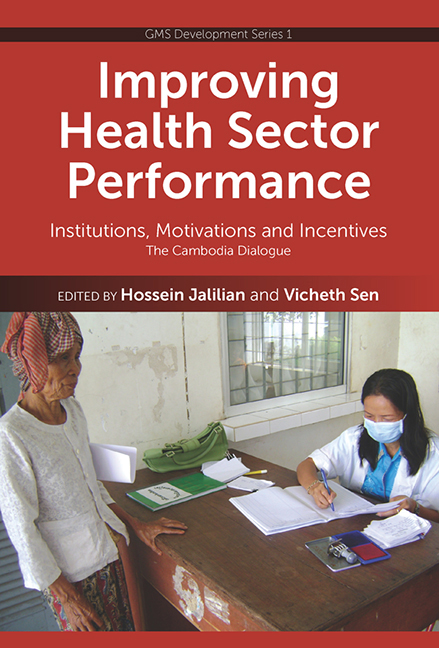 Improving Health Sector Performance
Improving Health Sector Performance Book contents
- Frontmatter
- Contents
- Acknowledgements
- Foreword
- List of Contributors
- Introduction
- Part I Overview
- Part II Organizational Arrangements: Purchasing Health Services
- 3 The Transition to Semi-Autonomous Management of District Health Services in Cambodia: Assessing Purchasing Arrangements, Transaction Costs and Operational Efficiencies of Special Operating Agencies
- 4 Vouchers as Demand-side Financing Instruments for Health Care: A Review of the Bangladesh Maternal Voucher Scheme and Implications for Incentives for Human Resource Management
- 5 Social Health Insurance in Cambodia: An Analysis of the Health Care Delivery Mechanism
- 6 Purchasing Health Services in New Zealand
- Part III Optimal Health Workers Contracts
- Part IV Managing Doctors and Nurses
- Part V Health Service Consumer Behaviour
- APPENDIX
- Index
4 - Vouchers as Demand-side Financing Instruments for Health Care: A Review of the Bangladesh Maternal Voucher Scheme and Implications for Incentives for Human Resource Management
from Part II - Organizational Arrangements: Purchasing Health Services
Published online by Cambridge University Press: 21 October 2015
- Frontmatter
- Contents
- Acknowledgements
- Foreword
- List of Contributors
- Introduction
- Part I Overview
- Part II Organizational Arrangements: Purchasing Health Services
- 3 The Transition to Semi-Autonomous Management of District Health Services in Cambodia: Assessing Purchasing Arrangements, Transaction Costs and Operational Efficiencies of Special Operating Agencies
- 4 Vouchers as Demand-side Financing Instruments for Health Care: A Review of the Bangladesh Maternal Voucher Scheme and Implications for Incentives for Human Resource Management
- 5 Social Health Insurance in Cambodia: An Analysis of the Health Care Delivery Mechanism
- 6 Purchasing Health Services in New Zealand
- Part III Optimal Health Workers Contracts
- Part IV Managing Doctors and Nurses
- Part V Health Service Consumer Behaviour
- APPENDIX
- Index
Summary
INTRODUCTION
The challenge of reaching the health related Millennium Development Goals has led to the search for new mechanisms of channelling resources to demonstrate the efficacy of pilot interventions for future scaling up and to benefit needy groups. Demand-side financing (DSF) mechanisms are an alternative way of targeting services to the poor instead of channelling funds to the supply side of health care. DSF mechanisms have received growing attention from governments and development partners (Gwatkin et al. 2005). Mixed evidence of the impact of government budget mechanisms in achieving goals (Chabot 2009) gives added impetus to the use of such instruments as DFS in Bangladesh. These discussions in the literature are particularly pertinent given that the international debate on how to improve aid effectiveness increasingly turns attention to providing direct budget support.
DSF instruments attempt to transfer purchasing power to specified groups for defined goods and services rather than allocating all resources to the supply side, on the assumption that those in need are able to access services (Standing 2002; Pearson 2001; Ensor 2004). The interest in using DSF mechanisms rests on the observation that decades of investing in the supply side has not made a sufficient contribution to improved health care services and related improvements in health outcomes. Vouchers,3 a key demand-side instrument, can potentially address a number of public policy issues, including the underutilization of essential services (changing consumer behaviour), improving targeting of public subsidies to the needy (linking demand to supply), empowering consumers with a choice of providers (freedom of choice), and promoting provider competition and responsiveness (changing provider behaviour and serving as a human resource incentive to promote desired behaviour). Therefore, the use of vouchers can lead to the improved quality of health care services and ultimately the desired improvement in health outcomes.
While most past and recent initiatives to channel public funding to the demand side through vouchers has taken place in low-income countries (Nicaragua, Kenya, Uganda, Tanzania, Cambodia and Bangladesh), this instrument has also been applied and tested in high-income countries to increase the efficiency of public spending on social services (Meng et al. 2006; Van den Berg & Hassink 2008).
- Type
- Chapter
- Information
- Improving Health Sector PerformanceInstitutions, Motivations and Incentives - The Cambodia Dialogue, pp. 76 - 100Publisher: ISEAS–Yusof Ishak InstitutePrint publication year: 2011
